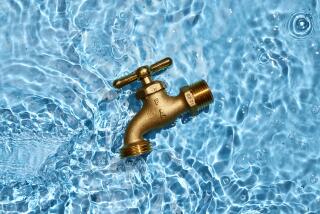Getting the Drop on Steel-Pipe Problems
Tom Houlihan’s realization that he had a problem on his hands came in waves.
Well, drips.
It started when he went down to his kitchen in the morning and heard water dripping in the sink. Assuming that the faucet wasn’t turned off completely, he reached over to give it a twist. That’s when a drop hit the back of his hand.
“I looked up and saw that water was dripping from the ceiling. I did more investigating and found that the problem was a leaking piece of galvanized water pipe,” he says.
It took Houlihan and a friend 15 hours to replace the pipe, despite the fact that he’s no stranger to plumbing work around his house.
“With galvanized pipe, everything screws together, and to take one piece off, you have go to the other end of the attic.”
He’s moving from Garden Grove to a newly constructed home in Huntington Beach, and one of the things he was sure to check was the plumbing.
“I’ve been watching them put it together; I wanted to be sure they didn’t use galvanized steel water lines,” he says.
No one puts much thought into their plumbing until something goes wrong. And if the problem is related to old water lines, a big decision has to be made: Re-pipe or repair?
“Quite frequently, we get calls from people who can’t get their pipes repaired anymore,” says Chuck Vershaw of Cal-Coast Repiping in Brea. “Plumbers won’t work on them because the steel has become so brittle.”
The problem stems from the fact that nearly all water lines in homes and buildings from the 1940s to the late ‘70s were made with galvanized steel pipe. Galvanized steel created watertight connections, it was durable and it provided a clean surface for the water to flow through.
Perhaps more important for builders at the time, galvanized steel was much cheaper than copper. “Nowadays, copper is still a little more expensive than steel,” says Ron Albright of Albright Plumbing & Heating Supply in Los Alamitos. “However, the labor costs of putting a steel system together make it more expensive overall.”
As time goes on, minerals in the water react with the steel, and hard water deposits build up along the walls of the pipe. In some areas, they can break down the protective galvanized layer and rust can set in, which eventually eats a hole in the line.
But mostly, the deposits collect year in and year out, and slowly you notice that the water pressure isn’t what it used to be. “When we pulled the pipe out to make our repair, I couldn’t believe the shape it was in,” says Houlihan. “It looked like a clogged artery. It was amazing that water could get through there.”
Signs of pipe problems include leaking and anemic water pressure, rusty or brown water from faucets that haven’t been used in a while, and fixtures that seem to collect an inordinate amount of sediment.
“In a normal system, you should expect to get about 10 gallons per minute from each outlet,” says Vershaw. “In a worn-out galvanized system, you might get only 3 gallons.”
The hot water lines are often the first to go, because water travels through them more frequently. “Sometimes we’ll have people who want to change just their hot water lines because the pressure is so bad on them,” says Vershaw. “But when you do that you probably won’t see an appreciable difference in water pressure. The cold side has deteriorated as well and it won’t be able to keep up with the hot.”
Left alone over time, the lines will eventually clog up until nearly blocked, and the most you’ll get from the tap is a trickle. Although, of course, you’re saving on water bills, eventually something will have to be done.
This usually occurs when two or three pipes break out in leaks and you’ve been nickel-and-dimed into considering moving. Or, while planning a remodeling project, you decide that since a room will be added or redone, why not do something else while the house is in disrepair?
Galvanized steel lines are replaced exclusively with copper. “You don’t find the same kind of chemical reactions that you see with steel,” says Joel Gwartz of B. J. Discount Plumbing & Heating Supply in Garden Grove. “They stay cleaner and, consequently, last longer.”
A copper repiping project is no small venture, which is why most homeowners wait until the job absolutely, positively needs to be done. Expect to pay roughly $350 to $450 per outlet. The average two-bath home has six hot-water outlets and 10 cold outlets, for a price tag of $5,600 and up. The amount charged will vary due to the way your home is built and the ease with which the plumbing is accessed.
“Older homes with raised foundations generally have the best access,” says Albright. “You go underneath, cut off the old pipes and install new ones.”
The length of the job can also vary depending on its complexity and the number of workers the contractor uses. A large crew could conceivably repipe a small house in one day, while a bigger structure could take two weeks.
Consumers may soon be able to choose between copper and a special plastic plumbing system known as chlorinated polyvinyl chloride, or CPVC. Although it’s not approved for use in California, a state environmental report released in July concluded that the plastic water lines are safe and have excellent durability.
However, some environmental groups are challenging the report. If CPVC is approved, the cost of a repiping project could be cut significantly because of the price difference between copper and CPVC.
As Houlihan learned, the amount of labor involved in working with steel pipes makes it very undesirable. Instead of steel connections, which must be screwed in, copper connections are soldered or welded.
“It makes the job go much faster,” says Vershaw. “Instead of having to thread the pipe and then try to get it into place and connect it with large pipe wrenches in a tight space, you’re soldering the pieces together.”
Newer homes with concrete slab foundations generally are built with the water lines laid within the concrete. “In these situations the steel lines are simply cut off and capped,” says Albright. “Then the new copper system is run through the attic and down the walls.”
Because of the high cost of repiping, it pays to do your homework when considering contractors.
“There are a lot of bad jobs that are done out there,” says Scott Blanke of Central Plumbing & Heating in La Habra. “Some contractors will cut costs by not building the system according to code. I saw one where the workers removed a mirror off of a wall to open it up and get to the pipes behind it. Then after they were done, they simply glued the mirror back in place without patching the drywall.”
Copper water lines are generally available in three thicknesses. Type ‘K,’ the thickest and most expensive, is used in commercial applications. Type ‘M’ is the thinnest, and while it’s approved for residential use, it’s usually not recommended. ‘L,’ of medium thickness, is most commonly used in homes.
“Make sure that if you’re paying for a higher grade of copper pipe, that’s what you’re getting,” says Blanke.
“Our goal is to install a new water pipe system and leave the structure without a trace of evidence that we’ve been there,” says Vershaw. “That’s not easy to do sometimes.”
Because of the nature of the work, some walls must be pierced to feed the new plumbing through. Check that your contractor’s estimate includes the patching of walls and ceilings, including paint or new wallpaper if necessary.
“Also, make sure that there will be no exposed pipe,” says Gwartz. “Good installers will do the extra work of cutting into walls as necessary to do the job right.”
Building codes specify that water lines in Southern California should be properly earthquake-strapped and pressure relief valves should be installed. “If the contractor tells you that you don’t need that stuff, you need to talk to someone else,” says Vershaw.
As with any professional, check on the prospective contractor’s license. “Ask to see a job they’ve done or watch their crew work at a site,” says Vershaw. “A good contractor will welcome that.”
More to Read
Sign up for Essential California
The most important California stories and recommendations in your inbox every morning.
You may occasionally receive promotional content from the Los Angeles Times.










